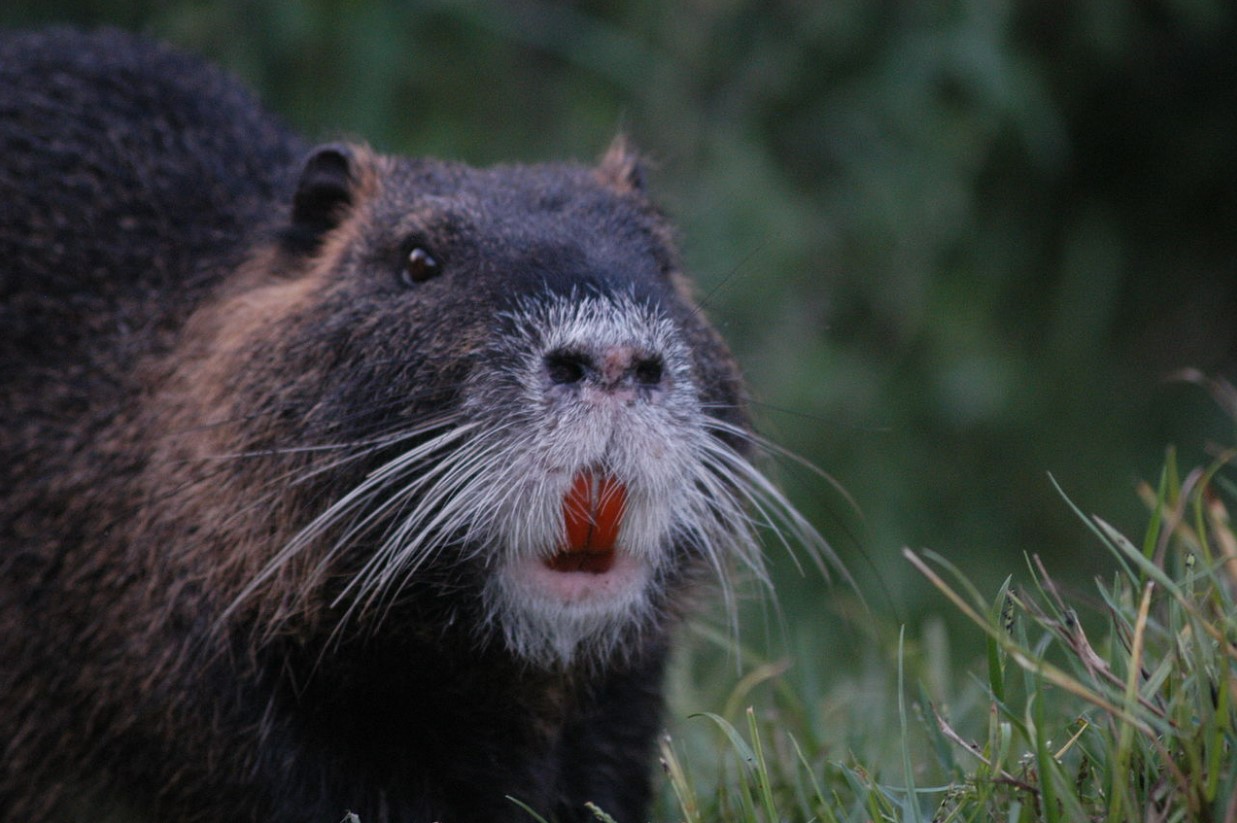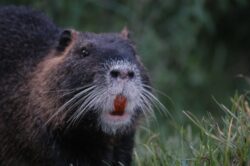Nutria in Louisiana
Imported in the early twentieth century for their fur, nutria have exploded into an invasive species that contributes to coastal erosion.

Wikimedia Commons
Nutria.
Nutria, a large semiaquatic rodent from South America, scientifically identified as Myocastor coypus, is an invasive species introduced to Louisiana in the 1930s that quickly overran the coastal region by the middle of the twentieth century. During the 1960s and 1970s, the animal was a sought-after target for local fur trappers. By the 1980s, however, any commercial demand for nutria fur melted away, and the animal contributed to a growing crisis of erosion along the coast. The rise and fall of the market for nutria reflects a growing awareness of the importance of coastal zones nationally and marks a successful blueprint for state intervention.
By the end of the 1800s the national depletion of animals hunted for fur such as beaver and buffalo combined with an exploding human population to increase demand for local hides. The market grew slowly in the early 1900s but exploded with the popularity of knee-length muskrat coats in the 1920s, when Louisiana furs commanded top dollar. Marshes, formerly seen as “wastelands,” were envisioned as endless fields of potential profit. Local politicians such as Leander Perez, who was infamous in his time, cut their teeth on corrupt deals involving muskrat leases in Plaquemines and St. Bernard Parishes. Locals in Saint Bernard attempted to fight back during a violent encounter known as the 1926 Trapper’s War. Soon however, marsh values would skyrocket not due to fur but from the black gold that bubbled from underneath, oil.
From Argentina to Louisiana: Nutria’s Origin
It was in this competitive environment that prospective fur farmers first imported nutria. In Shane K. Bernard’s article “The Nutria Nuisance,” the author lays the foundation for nutria’s introduction to Louisiana. Interested parties brought nutria from Argentina to North America in the early twentieth century, and to Louisiana by the 1930s or earlier. Bernard convincingly argues that businessman Edward Avery McIlhenny, also recognized for his involvement in wildlife conservation, was not the first nor sole importer of nutria to the state. However, McIlhenny did release breeding pairs into south central Louisiana and sell to other prospective fur breeders.
After McIlhenny’s well-intentioned but ill-fated first release in 1940, nutria quickly gained a foothold in the swampy and marshy coastal parishes. The animal’s impact was large enough by 1946 for the state legislature to pass Act 197, which listed the animal as a protected furbearer. Trappers skinned eighteen thousand nutria hides for market that year and fetched decent prices from at least one local fur buyer. This coincided with an explosion of muskrats that had ecological ramifications, which became known as The Great Muskrat Eat Out (1948–1951). An eat out occurs in the marsh when an exploding population of rodents consumes plant roots, leading to the deterioration and death of the plants, which exposes sediment to erosion and creates new expanses of open water. Between 1946 and 1949, state fur biologist Ted O’Neil conducted an audit of coastal furbearers and found great stretches of marsh gnawed to tatters by muskrat.
This transition coincided with massive changes to the coastline wrought by long-term man-induced forces such as river management and canalization of the coast. Since colonial days, levees, used as flood protection, cut off the renewing influence of the Mississippi River’s fresh waters and sediments to coastal areas. Canals used to move felled cypress trees sliced through the wetlands in the late 1800s, and progressively more canals were cut for the oil field during the twentieth century. All contributed to saltwater intrusion and the slow death of the coast.
As muskrat populations spiked then petered out by 1951, nutria, a more adaptive and somewhat salt tolerant rodent, took hold. Their growth was partially aided by the Louisiana Department of Wildlife and Fisheries, which imported nutria to the state wildlife refuge at Pass-a-Loutre in south Plaquemines Parish in southeast Louisiana. State fur officials such as Armand P. Daspit showered prospective praise upon the animal as the new hope for the fur industry. By 1953, however, O’Neil, Daspit’s replacement as head of the fur department, doubted that native muskrat could compete with nutria. Trappers were also slow to change tactics to better process nutria as prices dropped after the first five years of the animal’s official recognition as a state protected fur bearer. The unprofitability of nutria led to an exploding population, which increased levee and crop damage during the mid-1950s and contributed to a growing perception that the animals were a nasty menace. Storm inundation from Hurricane Audrey in 1957 pushed nutria north into valuable agricultural fields. Such events led to a proposed bounty by the state legislature in 1958. Despite passage of the bounty, funds were never set aside. However, the animal was declared an “outlaw” and protection removed.
The Return of the Rat
The fur market entered an uncertain period as fur farming increased but demand for wild-caught nutria fur also steadily crept upward. Various schemes emerged to make nutria profitable in the early 1960s, including using them as horse and pet food. Arguably, though, the most impactful was a manufacturing technique that separated the rough over fur from the soft under layer. With rising pelt prices, the animal was once again listed as a protected fur bearer in 1965. By the end of the 1960s, the price stabilized, and nutria trapping entered a heyday.
The advent of synthetic fabrics, the rising power of the animal welfare movement, and the increase in global temperatures all contributed to a decline in the fur market by the mid- 1980s. Nutria populations quickly rebounded. Observations by state fur biologist Greg Linscombe, O’Neil’s replacement, pointed to massive eat outs along the coast. This realization came during larger conversations on coastal erosion. As early as the 1950s, observers noted the state’s retreating coastline. By the 1970s, locals in coastal parishes such as Terrebonne sounded the alarm of a possible ecological collapse. This coincided with the emergence of coastal studies in universities. By the 1980s, grassroots efforts such as the Coalition to Restore Coastal Louisiana prompted politicians such as John Breaux to pass the Coastal Wetlands Planning, Protection and Restoration Act, also known as the “Breaux Act,” in 1990. As concern over the coast grew, Linscombe and others pushed for acknowledgment that nutria contributed to the problem, and the animal was listed as an “invasive species.” Over the 1990s, the conversation shifted to reintroduction of a bounty and the Coastwide Nutria Control Program (CNCP) was finally introduced in the 2002–2003 trapping season paying four dollars a tail and registering an annual harvest average of around 400,000 animals. The success of the CNCP serves as a case study of an effective coastal management project. Importantly, the act employs local people and values local ecological knowledge with cash incentives.
